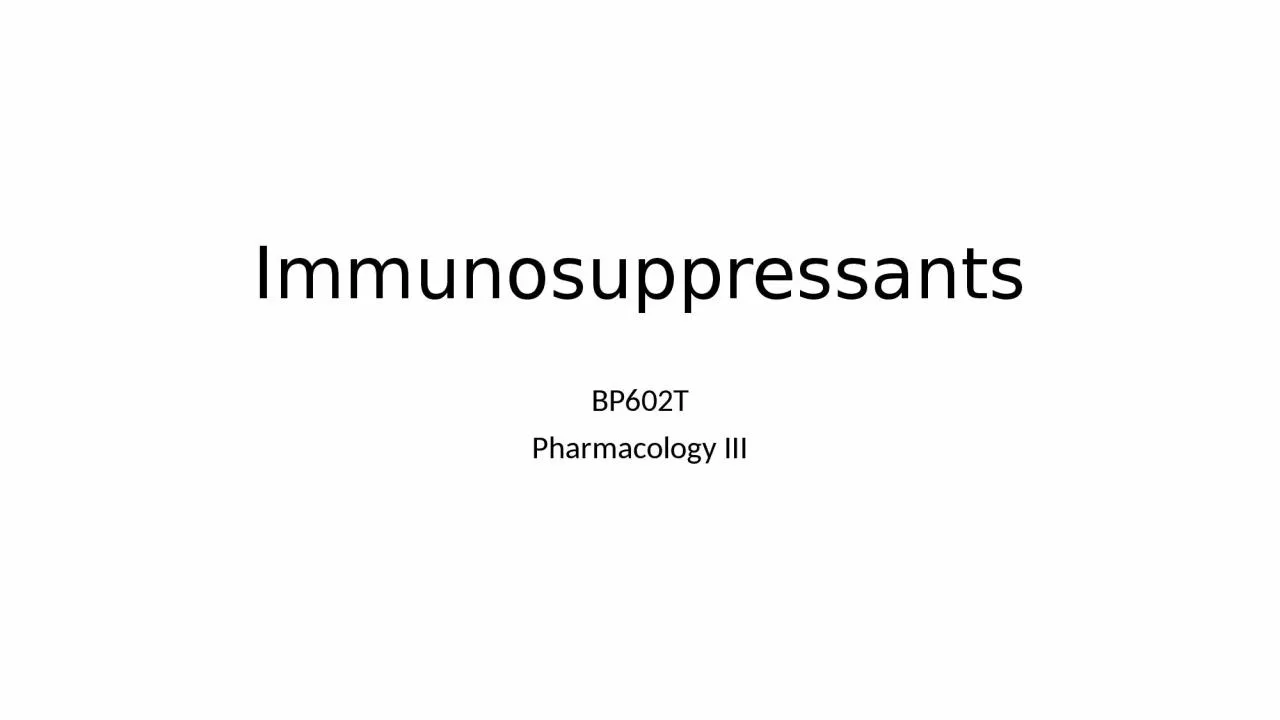

Pharmacology III Immunosuppressive drugs are useful in a Treating autoimmune diseases and b Preventing immunorejection of organ transplants Immunosuppresants may be classified as Calcineurin inhibitors Cyclosporine Tacrolimus ID: 999245
Download Presentation The PPT/PDF document "Immunosuppressants BP602T" is the property of its rightful owner. Permission is granted to download and print the materials on this web site for personal, non-commercial use only, and to display it on your personal computer provided you do not modify the materials and that you retain all copyright notices contained in the materials. By downloading content from our website, you accept the terms of this agreement.
1. ImmunosuppressantsBP602TPharmacology III
2. Immunosuppressive drugs are useful in: a) Treating autoimmune diseases; and b) Preventing immunorejection of organ transplants.Immunosuppresants may be classified as-Calcineurin inhibitors: Cyclosporine Tacrolimus Glucocorticoids Prednisolone Cytotoxic/antiproliferative agents Azathioprine Mycophenolate Sirolimus Antibodies (a) T cell depleting Muromonab Antibodies Antilymphocytic antibodies Antithymocytic antibodies (b) Anti CD25 Basilliximab Antibodies Daclizumab
3.
4. CYCLOSPORINE: The drug, formerly known as Cyclosporin A, is a cyclic undecapeptide (11 amino acid) produced by the fungus Beauveria nivea or soil/pathogenic fungus Tolypoclodium inflatum or Trichoderma polysporum. It has now been synthesized. MOA: Calcineurin is required for induction of a T cell specific transcription factor involved in synthesis of cytokines by activated T cells. Cyclosporine acts as a selective immunosuppressant; it blocks an early stage in the activation of cytotoxic T lymphocytes after the recipient is exposed to the antigen. Within the T lymphocytes, it binds to an intracellular protein cyclophilin/cytophilin C and form complex, this complex then inhibits calcineurin.P’kinetics: Given orally, its bioavailability is 20 - 50%. In the circulation, 50% is bound to erythrocytes, 10% to leucocytes and 40% to lipoproteins in the plasma. It is almost completely metabolised, by CYP3A4.ADRs: Nephrotoxicity, hypertension and hyperlipidemia; the others are hypertrichosis, gum hypertrophy, increased susceptibility to infection, leucopenia thrombocytopenia and development of lymphomas caused by Epstein-Barr virus.
5. TACROLIMUS: It is a macrolide antibiotic isolated from Streptomyces tsukubaensis. It binds to an immunophilin (FK binding protein); the complex inhibits calcineurin, thereby inhibiting activation of T cell specific transcription factor.Tacrolimus is 100 times more potent than cyclosporine as an immunosuppressantGiven orally, its bioavailability is variable and is reduced by food. The drug is extensively metabolised in the liver and less than 1% is excreted unchanged. It can also be given IV. Adverse reactions: These are similar to those of cyclosporine, with nephrotoxicity being the major toxic manifestation. Other adverse reactions include nausea, diarrhoea, neurotoxicity, hypertension, hypomagnesemia, hyperkalemia and hyperglycemia.MYCOPHENOLATE MOFETIL: This prodrug, given orally, is rapidly hydrolysed to the active compound, mycophenolic acid, which inhibits purine synthesis. It has a potent cytostatic effect on both B and T lymphocytes. This results in inhibition of lymphocyte proliferation and antibody formation.
6. SIROLIMUS: though structurally related to tacrolimus, differs in its mechanism of action. It forms a complex with circulating immunophilin but does not inhibit calcineurin. Instead, the complex binds and blocks a component of cellular signalling pathway involved in growth, proliferation and angiogenesis. Hence it is also termed as proliferation signal inhibitor (PSI).It is given orally, has a long t1/2 and is a substrate for CYP3A4 and p-glycoprotein.ADR include profound myelosuppression, especially thrombocytopenia, hepatotoxicity, diarrhoea, increase in cholesterol and triglyceride levels and pneumonitis.It is used alone or in combination with other immunosuppressants to prevent and treat rejection of solid organ transplant and GVH (graft versus host) reaction. Topically it is used for uveoretinitis. Sirolimus eluting intracoronary stents are also available; it inhibits cell proliferation in the endothelium, decreases neointimal hyperplasia and reduces the risk of in-stent stenosis